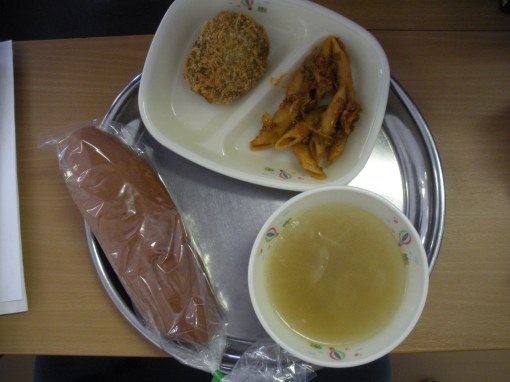March 4th, Monday:

- Miso Soup (Onion, Cabbage, Carrot)
- Simmered Hijiki and Atsuage (Hijiki Seaweed, Atsuage, Carrot, Green Bean, Konnyaku, Chicken)
- Breaded Teriyaki Mahimahi
- Rice
- Milk
- Kcal: 814
Hijiki is a a food lots of Calcium and Iron, for which we need to build strong bones and prevent anemia. It also has a lot of zinc, which prevents distortion of our sense of taste.
Hijiki and atsuage is yummy! Today, I told my students that we call the fish today, “mahimahi” and they thought that was pretty amusing. Like Hawaiian, Japanese has many words made of repeating sounds, but most of them are onomatopoeia, so a word like “mahimahi” sounds a bit strange as a fish’s name. That said, it was tasty.
Anyway, I was reading a book about Moribe, a Japanese philosopher back in the day who stressed the importance of not abandoning Japanese classics in favour of Chinese\Western books. He argues that, in Japan, Japanese classics should be considered the base of knowledge but that foreign books are nice for supplementing them. And he compares this eating etc:
“Rice and fish are enough to fill one’s belly, but how much more satisfying it is to have vinegary dishes and seasoned vegetables. In much the same way, a man who already has a wife is still happy upon acquiring a concubine.”
I think this is an interesting quote, because it illustrates that in Moribe’s time, rice and fish were considered the basis of diet, and vegetables were considered more of a delicious addition, like dessert. Perhaps that mindset still as influence today, and explains why vegetables are better received by most Japanese children?
I love you Moribe!!!

みそ汁
ひじきと厚揚げの煮物
シイラ照焼味フライ
ごはん
牛乳










